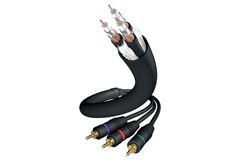Component video signals are used primarily in connection with high-end video equipment such as DVD players, projectors and flat panel displays. Therefore, the Component standard is also close to the pinnacle of analogue video transmission. The standard is originally from the US and actually corresponds to the European RGBS video standard used in SCART cables, although it should not be confused with it. Component signal is a lossless, compressed RGB signal using only three conductors with the sync signal integrated, whereas RGB has separate sync.
Component and RGB video transfers stand out by giving a visibly more colourful and calm image, yet less noise than both composite and S-video transfers, and are clearly recommended if possible. In addition, Component video is able to carry a true HD signal up to 720p (progressive) or 1080i (interlaced) resolution, unlike the others which only go up to 480p (NTSC) or 576p (PAL).
For transmission of component video signals, as for all other analogue video signals, coaxial cables with an impedance of 75 ohms are used for optimum quality. If the cable does not have the correct impedance, it will often result in shadows in the image. Component cables do not transmit audio signals, which are usually routed as a separate cable.

